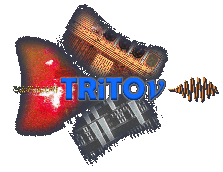For non-scientists this project webpage may raise different questions about the aim of TRITON and the exploitation of its findings. In a try to answer them without scientific and technical terminology, the following sections address the most important questions that may have been raised by the interested reader. In case your interest did not get satisfied, feel free to contact the technical coordinator for further information.
What is it all about?
In a nutshell TRITON is a technology project funded by Austrian research programmes and develops a next generation of integrated chips, similar as they are nowadays found inside personal computers or mobile phones. The big difference, however, is the compatibility with much higher signal frequencies with approximately millimeter wavelength and the presence of a second technology layer in these chips that will significantly boost their performance.
Conventional electronics chips as produced in masses and included in every electronic device have enabled the modern information age, reaching from telephony and television to the rollout of the modern internet and massive computational powers. The technology behind has been successively improved during the last decades. It is now possible to host 100s of millions transistors on a microprocessor with a size smaller than a fingernail – produced at a cost that guarantees technology that is accessible for everybody.
Nevertheless, when it comes to massive data through-put as fuelled through novel end-user applications, present chip solutions are reaching their limits. For this reason TRITON introduces a much higher signal carrier frequencies, which are subject to higher data modulation speeds, and a second “key enabling technology”, namely photonics that serves as backhaul for the electronically supported radio signals.
Why do we need photonics in addition to electronics?
…simply because technology based on light provides a better performance for simple tasks than technology based on electrons. An important fact is that the particles of light, the so-called photons, are much more “robust” for purposes of communications than their electrical counterparts, the electrons. For example, it is possible to transmit ~10.000-times more data over a single optical fibre compared to an electrical cable and on top of this, the overall communication link is more energy efficient, leading to a greener solution and a global reduction of wasted electrical power.
When talking about “links”, one can imagine different use cases for photonic technologies. On the one hand, these can be communication links between buildings, cities or continents: At the moment, it is possible to transmit more then 100 Tb/s over a fibre as thin as a human hair. Moreover, photonic links allow us to operate networks over much longer distances, e.g. more than 10.000 kilometres.
Furthermore, antenna signals are in most cases directly converted to optical signals in order to feed them back to the core of the telecommunication network, this time over shorter distances up to typically 20 km. This is the main aspect addressed within TRITON.
On the other hand, these links can be also between processor cores or between a processor and memory chips hosted on the same motherboard. Also here it is required to reach capacities in the order of more than a Tb/s when it comes to data centres. Note that a Terabit/second is ~20.000-times the capacity a wireless LAN link can achieve.
Still, although photonics provides access to super-fast communication links, there are yet no intelligent photonic building blocks that can perform mathematical operations as a microprocessor is easily performing. For this reason, the interplay between both worlds, photonics and electronics, is as important as the inclusion of a photonic layer in the next-generation of “optoelectronic” chips. This kind of chip can be thought like two separate chip layers, one for photonics and one for electronics, being brought together like the two breads of a sandwich and acting as a single chip device thanks to an interposer technology that enables the seamless interplay between photonic and electronic chip components.
What are the specific goals of TRITON and how does its outcome look like?
TRITON aims at developing the technological building blocks for integrating key functions required for applications in a modern mobile fronthaul network and base station equipment - with emphasis on mm-wave systems as they are intended to be used in upcoming 5G radio networks in a plurality of applications such as conventional radio communication, industrial environments, vehicular communications, and others. This task includes the physical design of electronic power and low-noise amplifiers, photonic transceivers, and their joint optimisation for 2.5D co-integration on an interposer bench in order to unlock the synergy of the two technology layers.
The output of the project will be a mm-wave system-on-interposer that can be flexibly used in many fields of wireless communications. The difference to conventional electronic chips will not really be visible from the outside – the only difference in its appearance will be a thin optical fibre that originates at the surface of the chip package used to interact with other optoelectronic chips through a purely photonic interconnect at high data throughput.


